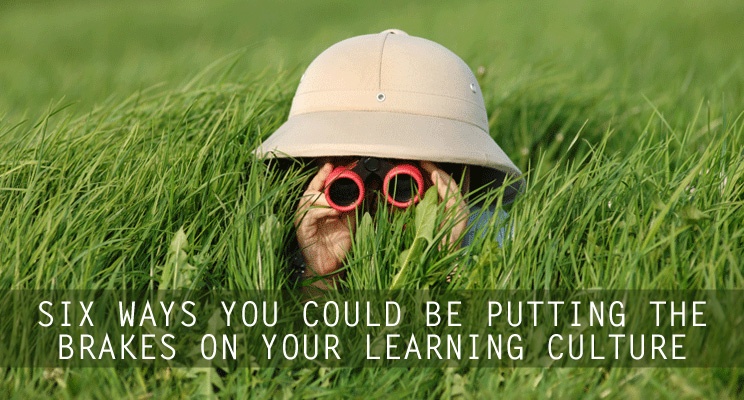
It’s slow and steady work. An organization engaged in building a learning culture is already tuned into the business value of managing—and protecting—their hard-earned, hard-learned knowledge base. That base of innovation, processes, networks, databases, best practices, and documents that collectively maintain the health and wealth of the business.
Tools to support that effort are varied and launch regularly. Most are technology based: Curation tools. Knowledge sharing intranets. Social media platforms. Course authoring, storage, and distribution systems. Access to all manners of channels and tubes of informal learning.
Still! A key often overlooked practice underlying any of these efforts has nothing to do with technology. No dollars required; just a bit of disciplined attention.
The practice: Checking our assumptions about what’s worth collecting and who holds it, mainly. I’ve heard them and you’ll recognize them. Six of my favorites are outlined here. Each in their own way are slightly or seriously dangerous to the goal.
1
Sometimes assumed
“WE’VE GOT IT COVERED” is closely related to “NOT TO WORRY. IT’S IN THE SYSTEM.” WGIC comes into play as individual contributors, mid-level managers, senior leaders and long-standing employees prepare to leave their posts.
Possible damage
Even if good information has been documented (and often is hasn’t), could someone actually find it in that system when they need it? And without the annotation layer, the layer that explains what makes good examples good—it’s not really “covered.”
Suggestion
Avoid assuming that things are recoverable or covered in ways that are actually useful.
2
Sometimes assumed
“WE GET IT. WE KNOW WHAT THE WORK INVOLVES.” Often heard with “NO NEED TO COLLECT THAT. WE’VE GOT OTHER PEOPLE DOING THE SAME THING.”
Possible damage
Three, five, or ten different people with the same job title will do the work differently, see different opportunities for innovation, work with different customers, rely on different networks, and have their own approaches or insights.
Suggestion
Acknowledge that you and those other three, five, or ten don’t know all there is to know about a role or all the different ways it can be done.
3
Sometimes assumed
WE’LL CHECK IN WITH THE KEY KNOWLEDGE HOLDERS.
Possible damage
“Key” is the tricky word here. Assuming that the know-what, know- how and know-why of people with more limited roles or shorter job titles is less worthy of tapping—is shooting oneself in one’s organizational feet. You can’t be certain who holds the “key” details. (See #6)
Suggestion
Make capture decisions on the KEY WHAT as well as the “WHO ELSE?” Know what’s critical or has high potential for dot connection. Tap everyone with exposure to the Key Whats.
4
Sometimes assumed
“FAILURES DON’T BELONG IN OUR KNOWLEDGE BASE.”
Possible damage
Costly? Initially yes. Possibly embarrassing. But hugely valuable lessons learned can go missing if not captured.
Suggestion
Failure is underrated and under-tapped. Do some of your best, most timely, least judgmental capture work on your failures and misses. (Close calls count here too.)
5
Sometimes assumed
PEOPLE DON’T WANT TO SHARE THEIR KNOWLEDGE. Or, PEOPLE WON’T TAKE THE TIME TO SHARE.
Possible damage
Smart things of all shapes and descriptions go undocumented and unfiled. Access and future dot connections are lost.
Suggestion
Make the time—it’s likely high ROI for the time spent.
Don’t be so sure people don’t want to share. Ask nicely. Ask with acknowledgement. Explain how the information is likely to make a difference.
Set knowledge sharing as an expectation from Day One. You never want to hear “Well, they never asked me.”
6
Sometimes assumed
SMALL DETAILS—BITS AND PIECES—AREN’T AS IMPORTANT AS THE BIG STUFF.
Possible damage
Transitions of all kinds tend to open gaps and make cracks visible. It’s the small things that are easiest to lose, misplace, or forget in those gaps.
Suggestion
Given the chance to CONNECT to bigger pieces, small bits and pieces can make all the difference. Knowledge dots can’t be connected until they’re collected. Large numbers do require some curation.
Take these six as an assumption checker’s checklist. Sorry everyone, there’s no app for this. And warning: this isn’t a complete list.
As a discipline, assumption checking belongs in the best practices manual of organizations striving to be more learner and learning oriented. When not practiced, shared mis-assumptions about what to collect, who to ask and what to collect become barriers to otherwise worthy culture building goals!
Have any thoughts or comments on this article? Contact us here, or check out more related blog posts at https://stccg.com/blog/.
